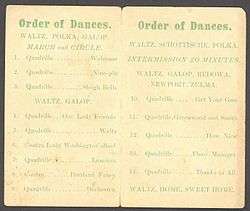Dance card
A dance card or programme du bal (also known by its German-language name, Tanzkarte) is used by a woman to record the names of the gentlemen with whom she intends to dance each successive dance at a formal ball. They appear to have originated in the 18th century, but their use first became widespread in 19th century Vienna, especially at the massive balls during Fasching before Lent.

An actual dance card is typically a booklet with a decorative cover, listing dance titles, composers, and the person with whom the woman intended to dance. Typically, it would have a cover indicating the sponsoring organization of the ball and a decorative cord by which it could be attached to a lady's wrist or ball gown. From the 19th century until World War I, dance cards for the elite of Austria-Hungary were often very elaborate, with some even incorporating precious metals and jewels.
In modern times the expression "dance card" is often used metaphorically, as when someone says "pencil me into your dance card," meaning "find some time to spend with me". Conversely, someone's "dance card is full" implies that even though they may be interested, they have no time for another person.
U.S. Air Force aircrews in general, and those involved in flight tests in particular, use the term to describe the first card in a "deck" of flight or test maneuver cards. The "dance card" contains administrative data about the mission, aircraft, and aircrew as well as a list of the maneuvers to be flown. The card serves as a table of contents for the mission and a quick reference for the aircrew's use during the flight.
Pictures
-

Dance card cover depicting 1884 U.S. presidential tickets
-

Inside of 1884 dance card
-

1912 Dance card of Gladys Ewing.
-

St John's Wood, Queensland (Australia) Dance Card 1886
External links
- See more examples of dance cards from the early 20th century at University of Houston Digital Library
- Shall We Dance? A collection of dance cards from Special Collections and College Archives at Gettysburg College (1882-1949). Retrieved August 17, 2015.